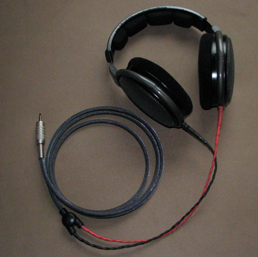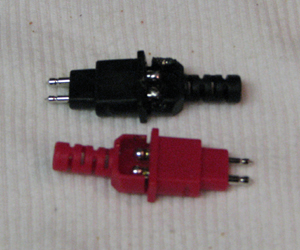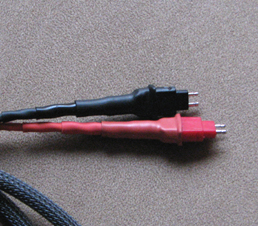Soldering the Cardas 580/600/650 Plugs
 First, an introduction on why I think it’s worth going through the trouble of soldering these nearly impossible little plugs:
First, an introduction on why I think it’s worth going through the trouble of soldering these nearly impossible little plugs:
I love the Sennheiser HD 650 headphones. It’s one of the three pairs I use for Mastering audio and trust them to give me an accurate low frequency response. When I check my masters over my Bowers & Wilkins 2.1 system, there’s never a surprise when it comes to the low end. I can’t say I trust these headphones completely for the entire frequency spectrum, but from everything that matters in the lows and low mids, these are money.
As you know, when talking about a high-end headphone system, the cans are only half of the story; pair these with a great DAC and Headphone Amp* and you have yourself a nice and trustworthy pair of headphones that are just a pleasure to listen to. Often times, these will sound better (as in “less hyped”) than “budget” full-range speaker systems, especially when you want a non-fatiguing listening experience.
*update: I’ve been using Schiit Audio’s Valhalla amp with the HD650 and in my opinion, it is the perfect amp for this headphone; it balances it out nicely and the mid range “veil” that had been there before when using it with other solid state amps is now gone. It must be the tubes!
This particular set of headphones is one that I’m very fond of because like many HD650 enthusiasts know, these need a little bit of time to evolve, and a couple of modifications to get them to sound their best. The matched drivers on the 650’s, in my opinion, take a few months to break in. When I first got mine about 5 years ago, the mid range sounded a bit veiled, so there was a period of time when I would leave them plugged in while playing pink noise for about two weeks and that seemed to help open them up, as well as playing back various kinds of material.
After having them for a few months, you might feel that the low end sounds a bit “cloudy” on these headphones. You’re not alone, many users feel the same way and someone found that if you remove the foam plugs from the drivers, that the low end opens up nicely. APureSound has an excellent tutorial on how to “bass mod” the drivers, here. After that, something to consider is buying an aftermarket cable (also available from APureSound) but if you’d like to build your own, as I did, this is where this article becomes useful. I haven’t found a detailed tutorial on how to solder the plugs, so I figured I’d show you how I did mine, (with additional consideration to strain relief). The focus of this article is soldering the plugs only. The cable build is similar to the one I did for my Beyerdynamic DT-770’s, and this one terminates to a Canare 3.5mm plug.
Tinning the Plugs
Using a “helping hands” accessory to hold the plugs in place, fill each terminal cup with Solder. You want to run your iron at about 30w and go in for no more than 2 seconds, otherwise you will melt the plug or distort it (using too little heat will do this, so you want to apply enough heat quickly enough to melt the solder but not have it there long enough to melt the plastic).
This is what the plugs should look like after “tinning” them with solder. You want just a little bit of solder coming out of each cup, next you’ll want to do the same to your wires, so that all you have to do next is apply heat to each terminal, and insert the wire in each cup. Don’t forget to slide the shrink tubing down the wires at this time. You’re going to need one piece of 3/16″ (longest piece), 1/4″ (middle length piece) and a 3/8″ piece which will cover the open side of the soldered plugs.
Soldering the Wires
After you have tinned your wires, you need to trim them to approximately 1/8″, but leave the second wire that you plan on inserting in the last cup slightly longer. This will help you insert the second wire as it will be slightly angled, making it a little easier to just bend into the cup.
Hot Gluing for Stability & Insulation
To add more insulation and stability to your soldered connections, hot glue is where it’s at. Pour enough to fill the entire cavity and if you over-do it, don’t worry, you can shave off the excess with a utility blade after the glue has cooled off.
Shrink Tubing for Strain Relief
The last step is sliding up the shrink tubing (that you did NOT forget to slide down each wire before soldering the plugs). Slide up the longest piece, which should be your 3/16″. This will cover the plugs included strain relief and give you another stage of stability there. Next, the 1/4″ piece that should be slightly shorter, giving you even more stability, followed by the larger 3/8″ piece that should go just beyond the base of the plug.
That’s it! If you have the necessary soldering skills, this cable upgrade will last you forever. I believe cables are like roads when it comes to signal (more room for signal to travel, to a certain degree helps with detail). The fun part about this particular modification is that you can take the original cable and plug them in to rule out a placebo effect. Good luck!







Thanks for the soldering tips, helped me a great deal in working the with the Sennheiser connectors for my DIY cable.
Glad you found the article useful! Good luck with your DIY cable projects!